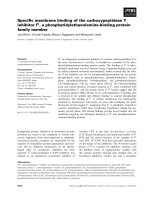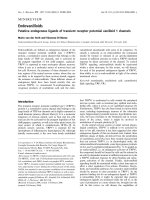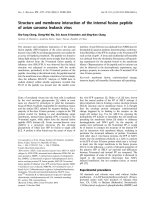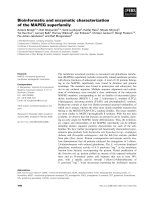Báo cáo khoa học: "Fatality after deliberate ingestion of the pesticide rotenone: a case report" docx
Bạn đang xem bản rút gọn của tài liệu. Xem và tải ngay bản đầy đủ của tài liệu tại đây (107.73 KB, 5 trang )
Open Access
Available online />R280
Vol 9 No 3
Research
Fatality after deliberate ingestion of the pesticide rotenone: a
case report
David Michael Wood
1
, Hadi Alsahaf
2
, Peter Streete
3
, Paul Ivor Dargan
4
and Alison Linda Jones
5
1
Specialist Registrar in General Medicine and Clinical Pharmacology, Department of Pharmacology and Clinical Pharmacology, St George's Hospital
Medical School, London, UK
2
Consultant in Anaesthetics and Intensive Care Medicine, Kingston Hospital, Kingston, Surrey, UK
3
Head of Clinical & Forensic Toxicology Section, Medical Toxicology Laboratory, Guy's and St. Thomas' NHS Foundation Trust, London, UK
4
Consultant Clinical Toxicologist, National Poisons Information Service (London), Guy's and St. Thomas' NHS Foundation Trust, London, UK
5
Director and Clinical Toxicologist, National Poisons Information Service (London), Guy's and St. Thomas' NHS Foundation Trust, London, UK
Corresponding author: David Michael Wood,
Received: 11 Jan 2005 Revisions requested: 14 Feb 2005 Revisions received: 29 Mar 2005 Accepted: 5 Apr 2005 Published: 29 Apr 2005
Critical Care 2005, 9:R280-R284 (DOI 10.1186/cc3528)
This article is online at: />© 2005 Wood et al.; licensee BioMed Central Ltd.
This is an Open Access article distributed under the terms of the Creative Commons Attribution License ( />2.0), which permits unrestricted use, distribution, and reproduction in any medium, provided the original work is properly cited.
Abstract
Rotenone is a pesticide derived from the roots of plants from the
Leguminosae family. Poisoning following deliberate ingestion of
these plant roots has commonly been reported in Papua New
Guinea. However, poisoning with commercially available
rotenone in humans has been reported only once previously
following accidental ingestion in a 3.5-year-old child. Therefore,
the optimal management of rotenone poisoning is not known.
After deliberate ingestion of up to 200 ml of a commercially
available 0.8% rotenone solution, a 47-year-old female on
regular metformin presented with a reduced level of
consciousness, metabolic acidosis and respiratory compromise.
Metformin was not detected in premortem blood samples
obtained. Despite intensive supportive management, admission
to an intensive care unit, and empirical use of N-acetylcysteine
and antioxidant therapy, she did not survive. Poisoning with
rotenone is uncommon but is potentially fatal because this agent
inhibits the mitochondrial respiratory chain. In vitro cell studies
have shown that rotenone-induced toxicity is reduced by the use
of N-acetylcysteine, antioxidants and potassium channel
openers. However, no animal studies have been reported that
confirm these findings, and there are no previous reports of
attempted use of these agents in patients with acute rotenone-
induced toxicity.
Introduction
Rotenone is a botanical pesticide derived from the roots of
species of plants from the family Leguminosae. Most commer-
cially available preparations are derived from the species Der-
ris elliptica, Derris mallaccensis, Lonchocarpus utilis and
Lonchocarpus urucu. It has pesticide activity against a wide
variety of insects and arachnids encountered in both domestic
and commercial horticulture on bush and vine fruits, fruit trees,
shade trees, flowers, shrubs and vegetables [1]. Ingestion of
naturally occurring rotenone was previously commonly
reported as a method of deliberate suicide in natives of New
Ireland in Papua New Guinea, who were seen to eat the roots
of plants known to contain rotenone prior to their death [2].
There has been only one other reported fatality, in a 3.5-year-
old girl, following ingestion of commercially available rotenone
solution [3]. Because the deliberate ingestion of commercially
available rotenone in humans is uncommon, the optimal man-
agement of rotenone poisoning is not currently known. We
report here a case of a fatality following ingestion of commer-
cially available rotenone that did not respond to maximal sup-
portive care and treatment with N-acetylcysteine (NAC) and
other antioxidants.
Case report
A 47-year-old woman weighing 64 kg and with known type 2
diabetes mellitus managed with metformin (500 mg three
times daily) presented after she had ingested up to 200 ml
from a bottle of 0.8% rotenone solution (Bio Liquid Derris
Plus™; PBI Home & Garden Limited, Waltham Cross, UK). The
maximum dose ingested would therefore have been 1.6 g,
equating to 25 mg/kg. She was bought to the emergency
GCS = Glasgow Coma Scale; LD = lethal dose; NAC = N-acetylcysteine; NADPH = nicotinamide adenine dinucleotide phosphate, reduced form.
Critical Care Vol 9 No 3 Wood et al.
R281
department having been found collapsed and unconscious at
home by her family, with a history of vomiting.
Her initial Glasgow Coma Scale (GCS) score was 3/15 and
she was therefore intubated and ventilated; she had no
requirement for sedative or paralyzing agents. After intubation,
her blood pressure was 93/52 mmHg and heart rate 87 beats/
min. Her electrocardiogram showed sinus rhythm. Baseline
blood investigations showed normal renal function, but liver
dysfunction with an elevated alanine transaminase of 233 IU/l.
Arterial blood gases showed a severe metabolic acidosis (pH
7.09, arterial O
2
tension 24 kPa, arterial CO
2
tension 4.3 kPa,
HCO
3
10.3 mmol/l, base excess -19 and lactate 13 mmol/l).
She was therefore commenced on continuous venovenous
haemodialysis with lactate-free dialysate and infusion of 50 ml/
hour sodium bicarbonate for management of her metabolic
acidosis. Computed tomography scanning showed no intrac-
ranial abnormalities to explain her reduced GCS. She was
transferred to the intensive care unit, and the National Poisons
Information Service (London) was contacted for further advice
on management.
A brown watery fluid (30 ml), similar to commercially available
rotenone in smell and consistency, was noticed via nasogas-
tric aspiration 6 hours after ingestion. Because previous in
vitro studies have demonstrated a benefit of NAC and antioxi-
dants in preventing rotenone toxicity in human cell lines [4-6],
she was treated with intravenous NAC (standard Prescott pro-
tocol 1979) and other antioxidants (including multivitamins, 5
ml/day ketovite [orally] and 125 mg zinc sulphate three times
daily [orally]) empirically. Also, 200 mg/day iron was adminis-
tered intravenously; this has been shown to activate ATP-
dependent potassium channels, which is protective in roten-
one-induced toxicity [7].
She remained hypotensive despite fluid resuscitation, and her
cardiac index on oesophageal Doppler studies was 7.7 l/min
per m
2
with a stroke volume of 97 ml and systemic vascular
resistance index of 470, indicating the presence of a vasodi-
lated high output state. She was therefore commenced on a
noradrenaline (norepinephrine) infusion in order to maintain
her blood pressure, with a maximum dose 0.35 µg/kg per
hour. Repeat cardiac studies using pulse contour cardiac out-
put 12 hours after the initial presentation revealed a worsening
cardiac index (2.5 l/min per m
2
), with a reduced stroke volume
of 30 ml and an increased systemic vascular resistance index
of 2359, indicating the presence of a vasoconstricted low out-
put state. She was therefore started on dobutamine (maximum
dose 10 µg/kg per h) and weaned from the noradrenaline infu-
sion.
After initial stabilization of her clinical state with maximal sup-
portive care, she then started to deteriorate clinically, with
signs of cardiovascular collapse and no signs of obvious neu-
rological recovery. At 48 hours after admission she suffered an
asystolic cardiac arrest, which did not respond to cardiopul-
monary resuscitation. At postmortem there were signs of mul-
tiorgan failure, with pulmonary oedema and congestion of the
heart, spleen and kidneys. The liver was icteric with centrilob-
ular necrosis and general disintegration.
Results
Samples of serum were obtained at the time of admission and
analyzed locally and by the Medical Toxicology Laboratory in
London. There is currently no available method for the quanti-
fication of rotenone concentrations, and we were unable to
identify a suitable technique for rotenone analysis. However,
analysis of serum samples failed to detect the presence of
other drugs, including drugs of abuse, alcohol, barbiturates,
anticonvulsants, or tricyclic antidepressants. Importantly, there
was no detectable metformin in the serum samples that could
have accounted for the patient's lactic acidosis.
Discussion
Poisoning with the plant-derived pesticide rotenone is uncom-
mon and potentially fatal. In the case presented here, the
patient presented after ingestion of up to 200 ml of a 0.8%
(1.6 g) commercially available rotenone solution (Bio Liquid
Derris Plus™) with a reduced GCS score and significant met-
abolic acidosis. Despite meticulous supportive care in the
intensive care unit and treatment with NAC, and empirical use
of antioxidants (oral multivitamins, oral zinc sulphate and intra-
venous iron), she did not survive.
Rotenone is a pesticide derived from the roots of members of
the Leguminosae family of plants. The roots of these plants
were used for many years by the Chinese because of their
pesticidal actions [1]. It was first extracted from these plant
roots in 1895 and was patented for use as a pesticide in the
UK in 1912, although the chemical structure of rotenone was
not determined until 1932. Rotenone has been demonstrated
to have activity against a wide variety of insects and arachnids,
and against vertebrate fishes [1,8]. Commercially available
rotenone is limited mainly to domestic use because it rapidly
decomposes when exposed to sunlight and the duration of its
biological activity is approximately 1 week after use.
Authors have previously reported that ingestion of plant roots
known to contain rotenone was common among individuals
attempting suicide in the New Ireland region of Papua New
Guinea [2]. Although no assays to confirm rotenone ingestion
were available, individuals were often seen to have been eat-
ing the plant roots before their death, or the chewed roots
would be found in close proximity to a deceased individual.
The deliberate or accidental ingestion of commercially availa-
ble rotenone is uncommon, and there has been only one other
case report of a fatality, in a 3.5-year-old girl, following acci-
dental ingestion of rotenone [3].
Available online />R282
The toxicity of rotenone in animal studies is variable. The 50%
lethal dose (LD
50
; i.e. the dose required to kill 50% of the pop-
ulation studied) varied from 13 to 130 mg/kg in guinea pigs [9-
11] and from 25 to 132 mg/kg in rats [9,10,12,13] to 1500
mg/kg in rabbits [11]. In humans the minimum LD is not
known, but death occurred in a 3.5-year-old child who had
ingested 40 mg/kg rotenone solution [3]. Some of the differ-
ences seen in the fatal doses of rotenone may reflect differ-
ences in the preparations that were used or ingested, in
addition to species differences in toxicity [14]. Higher doses
are required for water-based than for fat-based preparations,
because rotenone is very poorly soluble in water. Additionally,
in animals given rotenone by subcutaneous, intravenous, or
intraperitoneal routes, the LD
50
was much lower and this prob-
ably reflects the rapid first pass metabolism of rotenone by the
liver [11].
In animal studies, classical signs following acute ingestion of
rotenone include initial respiratory stimulation, followed by sig-
nificant respiratory depression and respiratory arrest [1].
Death occurs in the first 30 min in roughly half of animals given
intraperitoneal rotenone [10] and within 2 days in animals that
ingested oral rotenone [12]. Other features in animal studies
of rotenone toxicity include vomiting, incoordination, convul-
sions and muscular tremors. Postmortem studies in the ani-
mals that died also demonstrated pulmonary congestion
[10,15] and gastrointestinal irritation [10,11]. Individuals who
were known to have ingested plant roots in New Ireland were
reported to suffer from profound vomiting, dilated pupils and
feeble pulse before death, and autopsies in fatal cases
showed acute congestive heart failure [2]. In the previous
reported accidental overdose, the child suffered from vomit-
ing, severe metabolic acidosis (pH 6.76), drowsiness, coma
and respiratory depression leading to respiratory arrest [3].
Following death, postmortem studies showed anoxic damage
to the brain, lungs and heart, with an associated sero-haemor-
rhagic pleural effusion, acute tubular necrosis and significant
gastrointestinal irritation and haemorrhage. In the case
reported here, the patient presented to hospital with a signifi-
cant reduction in level of consciousness, associated respira-
tory depression and severe metabolic acidosis, and at
postmortem there were signs of multiorgan failure and signifi-
cant liver damage.
The toxicity of rotenone has been more widely investigated in
neuroblastoma cell lines and rotenone-induced animal models
of Parkinson's disease. In rats given systemic rotenone for up
to 20 days, 80% exhibited systemic toxicity with autopsy find-
ings of severe liver necrosis [16]. In models of acute toxicity,
rotenone was shown to cause both dose and time dependent
reductions in neuroblastoma cell line viability [4,17-19]. Mor-
tality in rats given subcutaneous rotenone was proportional to
the doses administered, with 0% mortality with 10 mg/kg
increasing to 40% mortality with 15 mg/kg [20]. Rotenone is
known to be a potent inhibitor of complex I of the mitochondrial
respiratory chain in all cell types, by inhibiting the function of
mitochondrial NADPH (nicotinamide adenine dinucleotide
phosphate, reduced form) dehydrogenase activity [5,6], there-
fore leading to a decrease in aerobic metabolism and develop-
ment of a lactic acidosis. This inhibition of the mitochondrial
respiratory chain leads to an increase in the production of
hydrogen peroxide, and superoxide and oxygen radical spe-
cies [6,21]. It is thought that the production of these oxidant
species is the mechanism by which rotenone exerts its acute
toxic effects, leading to fragmentation of DNA [6] and lipid per-
oxidation [6], increased lactate dehydrogenase release [4]
and an increase protein carbonyl concentration, which is a
marker of apoptotic cell death [5].
Inhibition of NADPH dehydrogenase within cells leads to a
deficiency in the conversion of oxidized NADP
+
to reduced
NADPH. This NADPH then is utilized by glutathione reductase
to act as an electron donor to convert oxidized glutathione to
reduced glutathione. Reduced glutathione acts within cells as
an antioxidant, reducing cellular damage caused by oxidant
molecules. In acute toxicity studies in the SH-SY5Y neuroblas-
toma cell line, rotenone concentrations of 5 µmol/l resulted in
significant increases in oxidized glutathione concentrations
and reductions in reduced glutathione concentrations [6]. Pre-
treatment of neuroblastoma cell lines with 100 µmol/l NAC
prior to rotenone exposure resulted in decreased markers of
oxidant stress, and levels of production of both hydrogen per-
oxide and superoxide oxygen radicals were reduced by
approximately 80% compared with those cells exposed to
rotenone alone [6]. Similarly, with pretreatment with NAC
before rotenone exposure, there was reduction in DNA frag-
mentation, lactate dehydrogenase release and other markers
of apoptotic cell death [4,6]. Additionally, overall neuroblast-
oma cell death was significantly reduced by pretreatment with
100 µmol/l and 500 µmol/l NAC prior to rotenone exposure
[4,6].
As well as the glutathione hypothesis for hepatotoxicity in
rotenone poisoning, in any patient who is hypotensive for a
period of several hours, the possibility that this hypotension
has caused 'shock liver' must be considered. Shocked liver is
best avoided by maintenance of an adequate mean arterial
blood pressure, but any hypotension should be controlled as
aggressively and as soon as possible, and oxygenation maxi-
mized for recovery to take place. Initial oesophageal Doppler
studies in this patient indicated a high cardiac index and
vasodilatation. Despite subsequent administration of NAC (a
hyperosmolar solution that is associated with vasodilatation
and increased cardiac index [22]), the patient's cardiac index,
as measured by pulse contour cardiac output, fell and she
became vasoconstricted. This was a very poor prognostic sign
indeed.
In addition to the previous studies using NAC to replenish glu-
tathione, other antioxidants have been tested in an attempt to
Critical Care Vol 9 No 3 Wood et al.
R283
prevent rotenone-induced toxicity. In the neuroblastoma cell
line SH-SY5Y, preincubation with the plant flavanoid fraxetin
produced comparable reductions in rotenone-induced cell
death and other markers of rotenone-induced cellular damage
to NAC [4,6]. Also, other antioxidants such as α-tocopherol
and coenzyme Q
10
have been shown to reduce rotenone-
induced cell death [5]. Potassium channel opening drugs such
as iptakalin [23] and diazoxide [24] also appear to reduce the
toxicity of rotenone in cell models. It is proposed that potas-
sium channel opening drugs cause prolonged hyperpolariza-
tion of cells, therefore leading to cellular protection. However,
the exact mechanism of cellular protection is unclear, because
some potassium channel opening drugs, such as glibencla-
mide, are only partly protective in preventing rotenone-induced
toxicity [23]. Other drugs shown to reduce rotenone toxicity in
neuroblastoma cell models include pranipexole [25] and pros-
taglandin A
1
[19].
However, no studies have been conducted in whole animal
models of rotenone-induced toxicity to confirm whether the
use of NAC, antioxidants and potassium channel opening
drugs reduce the toxicity of rotenone, as shown in neuroblast-
oma cell line studies. Additionally, there have been no other
reported cases of attempted use of NAC or other potentially
beneficial antioxidants in the management of acute rotenone
exposure or toxicity in humans. This patient had established
toxicity on presentation (coma, hypotension and severe meta-
bolic acidosis), and so it is difficult to predict, based on this
case, whether earlier intervention with agents such as NAC
would have an impact on outcome.
Conclusion
We describe here a case of a fatality following severe roten-
one poisoning. The patient presented with a reduced GCS
score and severe metabolic acidosis that did not respond to
meticulous supportive care, treatment with NAC and empirical
use of antioxidants. Other toxicological causes of the meta-
bolic acidosis, for example metformin toxicity, were excluded.
The optimal management of patients who present following
rotenone ingestion is still not known, but future use of NAC
and antioxidants shown in cellular models to reduce rotenone
toxicity may help to improve survival, although their use is cau-
tioned in patients with haemodynamic compromise.
Authors' contributions
HA was in charge of the patient's immediate care and manage-
ment. DMW, PID and ALJ were involved in providing specialist
advice concerning the management of this patient. PS under-
took the serum drug and toxicological analyses. DMW was
responsible for drafting the first draft of the manuscript and all
authors read and approved the final manuscript.
References
1. Ray DE: Pesticides derived from plants and other organisms.
In Handbook of Pesticide Toxicology Edited by: Hayes WJ Jr,
Laws ER Jr. New York, NY: Academic Press; 1991:2-3.
2. Holland EA: Suicide by ingestion of derris root sp. in New Ire-
land. Trans R Soc Trop Med Hyg 1938, 32:293-294.
3. De Wilde AR, Heyndrickx A, Carton D: A case of fatal rotenone
poisoning in a child. J Forensic Sci 1986, 31:1492-1498.
4. Molina-Jimenez MF, Sanchez-Reus MI, Benedi J: Effect of fraxetin
and myricetin on rotenone-induced cytotoxicity in SH-SY5Y
cells: comparison with N-acetyl cysteine. Eur J Pharmacol
2003, 472:81-87.
5. Sherer TB, Betarbet R, Testa CM, Seo BB, Richardson JR, Kim JH,
Miller GW, Yagi T, Matsuno-Yagi A, Greenamyre JT: Mechanism
of toxicity in rotenone models of Parkinson's disease. J Neuro-
sci 2003, 23:10756-10764.
6. Molina-Jimenez MF, Sanchez-Reus MI, Andres D, Cascales M,
Benedi J: Neuroprotective effect of fraxetin and myricetin
against rotenone-induced apoptosis in neuroblastoma cells.
Brain Res 2004, 1009:9-16.
7. Tai KK, Truong DD: Activation of adenosine triphosphate-sen-
sitive potassium channels confers protection against roten-
one-induced cell death: therapeutic implications for
Parkinson's disease. J Neurosci Res 2002, 69:559-566.
8. Gilmore RG, Hastings PA, Kulczycki GR, Jennison BL: Crystalline
rotenone as a selective fish toxin. Florida Scientist 1981,
44:193-203.
9. Lightbody HD, Matthews JA: Toxicology of rotenone. Ind Eng
Chem 1936, 28:809-811.
10. Shimkin MB, Anderson HH: Acute toxicities of rotenone and
mixed pyrethrins in mammals. Proc Soc Exp Biol Med 1936,
34:135-138.
11. Haag HB: Toxicological studies of Derris elliptica and its con-
stituents. I. Rotenone. J Pharmacol Exp Ther 1931, 43:193-208.
12. Lehman AJ: Chemicals in foods: a report of the association of
food and drug officials on current developments. Part II. Pesti-
cides. Section I. Introduction. Q Bull Assoc Food Drug Off 1951,
15:122-123.
Key messages
• Reports of rotenone toxicity in humans are rare and con-
sequently the optimal management of rotenone toxicity
is not known.
• In vitro cell line studies have suggested that rotenone
toxicity can be revented by the use of N-acteyl cysteine,
anti-oxidants and potassium channel openers. There
have been no animal studies to confirm these observa-
tions.
• In this reported case, the use of N-acteyl cysteine, anti-
oxidants and potassium channel openers did not alter
the outcome, although the patient had features of estab-
lished toxicity on presentation.
• Future use of NAC and antioxidants may help to
improve survival in patients with rotenone toxicity.
Available online />R284
13. Santi R, T'Oth CE: Toxicology of rotenone. Farmaco [Sci] 1965,
20:270-279.
14. Cutkomp LK: Toxicity of rotenone in animals. Soap Sanit Chem
1938, 19:107-123.
15. Ambrose AM, Haag HB: Toxicological study of derris. Ind Eng
Chem Ind Ed 1936, 28:815-821.
16. Lapointe N, St-Hilaire M, Martinoli MG, Blanchet J, Gould P, Rouil-
lard C, Cicchetti F: Rotenone induces non-specific central nerv-
ous system and systemic toxicity. FASEB J 2004, 18:717-719.
17. Seaton TA, Cooper JM, Schapira AH: Free radical scavengers
protect dopaminergic cell lines from apoptosis induced by
complex I inhibitors. Brain Res 1997, 777:110-118.
18. Kitamura Y, Inden M, Miyamura A, Kakimura J, Taniguchi T, Shimo-
hama S: Possible involvement of both mitochondria- and
endoplasmic reticulum-dependent caspase pathways in
rotenone-induced apoptosis in human neuroblastoma SH-
SY5Y cells. Neurosci Lett 2002, 333:25-28.
19. Wang X, Qin ZH, Leng Y, Wang Y, Jin X, Chase TN, Bennett MC:
Prostaglandin A1 inhibits rotenone-induced apoptosis in SH-
SY5Y cells. J Neurochem 2002, 83:1094-1102.
20. Antkiewicz-Michaluk L, Karolewicz B, Romanska I, Michaluk J,
Bojarski AJ, Vetulani J: 1-methyl-1,2,3,4-tetrahydroisoquinoline
protects against rotenone-induced mortality and biochemical
changes in rat brain. Eur J Pharmacol 2003, 466:263-269.
21. Sakka N, Sawada H, Izumi Y, Kume T, Katsuki H, Kaneko S, Shi-
mohama S, Akaike A: Dopamine is involved in selectivity of
dopaminergic neuronal death by rotenone. NeuroReport 2003,
14:2425-2428.
22. Jones AL: Mechanism of action and value of N-acetylcysteine
in the treatment of early and late acetaminophen poisoning: a
critical review. J Toxicol Clin Toxicol 1998, 36:277-285.
23. Yang Y, Liu X, Ding JH, Sun J, Long Y, Wang F, Yao HH, Hu G:
Effects of iptakalim on rotenone-induced cytotoxicity and
dopamine release from PC12 cells. Neurosci Lett 2004,
366:53-57.
24. Tai KK, McCrossan ZA, Abbott GW: Activation of mitochondrial
ATP-sensitive potassium channels increases cell viability
against rotenone-induced cell death. J Neurochem 2003,
84:1193-1200.
25. Schapira AH: Dopamine agonists and neuroprotection in Par-
kinson's disease. Eur J Neurol 2002:7-14.
26. Prescott LF, Illingworth RN, Critchley JA, Proudfoot AT: Intrave-
nous N-acetyl cysteine: the treatment of choice for paraceta-
mol poisoning. Br Med J 1979, 2:1097-1100.









